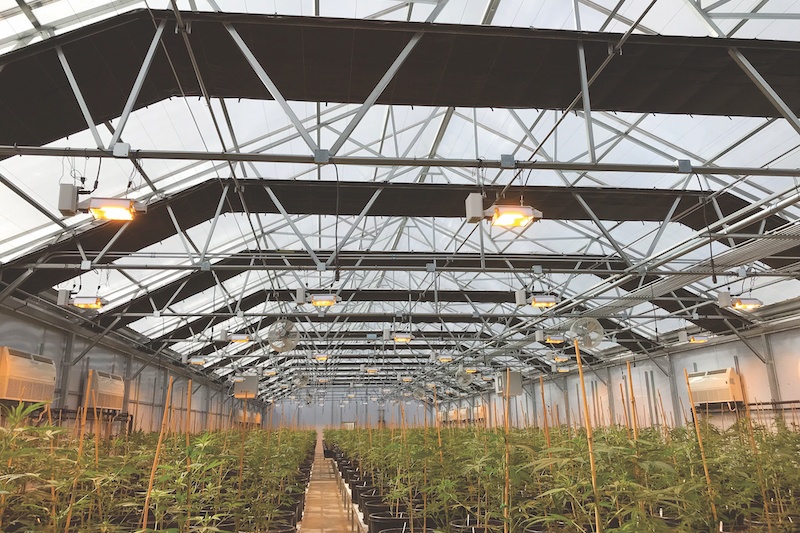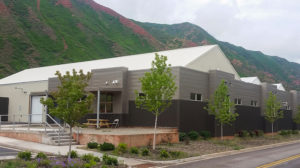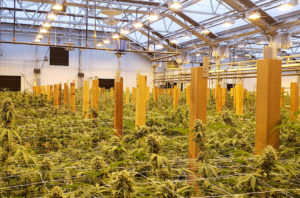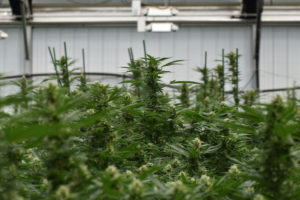
Maximizing Your Cannabis Greenhouse
There’s no such thing as a “one-size-fits-all” greenhouse for cannabis cultivation. Not if you want to ensure each of your crops reaches its full potential with high yields, lower operational costs, less water, and fewer fertilizers and pesticides.
You’ll need structures and advanced control systems that are carefully engineered for maximum growth. That’s because your geographic location and the desired ranges of temperatures and humidity control dictate which complete cannabis ecosystem is best for your new operation or expansion project.
The first major business decision, of course, is to choose the end use for the cannabis you cultivate — either harvesting the flower for smokable products or the plant to extract cannabinoids for edibles, gels and oils. Once that objective is clear, you’ll then want to consider how to design, construct, commission and operate a complete cannabis ecosystem.
Since constructing a complete greenhouse system can cost as much as $450 per square foot, discovering answers to the following six questions that are right for your business is essential in order to maximize your investment.
1. Greenhouse structure
Does the design support immediate requirements and easily scale for long-term growth?
Begin with greenhouse design, materials and equipment from a partner with proven cannabis cultivation expertise. Lots of suppliers manufacture greenhouses, but they may only work with producers of fruits and vegetables, flowers or plants for retail garden centers.

You’ll discover that greenhouse suppliers offer a broad range of glass and polycarbonate materials for walls and roofs and metal cladding for side walls in addition to structural options to reliably support piping, wiring, gutters and equipment. It’s a dizzying array of systems and technologies that must be perfectly engineered to solve the unique challenges presented by growing cannabis.
And when done correctly, greenhouses should be designed with complete electrical, heating, cooling, ventilation and drainage systems that can be easily expanded as your cannabis business grows.
2. Temperature and humidity
How will indoor environmental conditions be controlled to produce healthy plants and maximize yield?
Perhaps the most important process in the day-to-day operation of your cannabis greenhouse will be managing indoor temperature and humidity. Depending on your location — and the available sunlight and climate — it can be quite a challenge to maintain optimal temperatures and humidity levels inside a greenhouse.
Temperatures should be kept at 60 to 77° F through a combination of heating, cooling and ventilation systems. Shades installed to control natural light can also be utilized to create an insulating layer of air between the plants and the greenhouse roof. As an added benefit, shades can reduce the cost of heating or cooling the greenhouse by as much as 50%.
How temperatures influence greenhouse humidity is also a significant factor. Warmer air holds more water vapor (measured as relative humidity) than cooler air. Young cannabis plants in the growing stage take in more nutrition and water when relative humidity is as high as 70%. In the blooming stage, mature cannabis plants thrive when relative humidity is as low as 40%. Sophisticated HVAC and dehumidification systems must be engineered to reliably achieve an optimum balance and flexible enough to adjust to changing climatic conditions and plant needs.
3. Lighting
How will natural light and/or supplemental light be optimized?
The amount of light cannabis plants receive each day determines when flowering begins. In their early, vegetative stage, cannabis seedlings or clones need about 18 hours of light each day in order to grow stems and leaves. As they reach the flowering stage where budding develops, cannabis plants need 12 hours of light each day. In both lifecycle stages, greenhouse operators rely on a combination of sunshine and artificial sources such as light-emitting diodes (LEDs), high-pressure sodium (HPS) and high-intensity discharge (HID) lights.

How much of the light can be supplied naturally depends on the location of your greenhouse and local weather. Sites in southwestern U.S. states, for example, typically have more available sunshine than greenhouse sites in the Pacific Northwest. Too much sun can be controlled with shade systems and black-out curtains.
And, when there are not enough hours of natural light available, greenhouses can be designed with artificial lighting to provide the micromoles necessary for plants to convert nutrients into energy through photosynthesis. Modern LEDs are widely used because they deliver full-spectrum light with the added benefit of consuming up to 30% less electricity than sodium lights. LEDs also generate less heat, so they can be placed closer to plants without the risk of burning the tips of cannabis leaves or increasing the temperature inside the greenhouse.
4. Infrastructure
Does your greenhouse site have power, water, sewer and drainage to meet current and future needs?
Adequate electrical supply will be needed to power the artificial lights, pumps for irrigation and drainage systems as well as heating, cooling and ventilation (HVAC), and dehumidification equipment. Accurately estimating how much energy these systems will consume now — plus future needs as your cannabis business scales — is a critical step when evaluating potential greenhouse sites. This information will help you understand whether electrical service to the site can provide the needed energy, or what investment in additional power lines, substations and/or alternate services might be required.
Cannabis greenhouse operators also must plan to provide large amounts of potable water for irrigation and fertigation systems along with systems to capture, store and treat or reclaim runoff that includes fertilizers and oils from the cannabis plants. Most states strictly limit drainage off the greenhouse site and prohibit release directly into sewers or waterways. To meet these regulations, cannabis growers typically install drip irrigation methods that deliver water directly to the plants. They also can invest in direct injection fertigation or nutrient recipe tanks to irrigate and fertilize multiple, smaller sections of cannabis plants.
5. Legal requirements
What state and local security, safety and environmental laws or regulations must be met?
Cannabis greenhouse operators must comply with myriad state and local governmental requirements, including obtaining a license to grow cannabis for medicinal or recreational purposes. Among the many laws and regulations are these examples that determine how:
• close greenhouses can be sited to schools
• unauthorized access and theft of the cannabis plants can be prevented
• seeing what’s inside the structure can be blocked or obscured
• fertilizers in irrigation water are captured, stored and reclaimed

6. Skilled labor and automated processes
Is there an adequate pool of skilled labor available, and how much automation of greenhouse processes will be needed?
Decisions about the location operators choose for a cannabis greenhouse as well as how the facility will be designed and operated are heavily dependent upon the amount of available skilled labor.
Although all businesses grapple with chronic labor shortages, recruiting and retaining employees for cannabis cultivation can be acutely challenging because of the specialized knowledge and processes involved. Sites near large population centers may provide access to more workers but may also limit the number of sites with acreage to expand facilities as the cannabis business booms. Locating greenhouses in rural areas can make larger sites available for expansion but also can shrink the size of the nearby labor pool.
Cannabis operators can solve these challenges — and achieve more consistent quality while lowering overall costs — by automating greenhouse systems for lighting, irrigation, fertigation, HVAC and dehumidification.
Advanced equipment and software is available to simplify and accelerate employee training, control and monitor systems with fewer employees, and predict and analyze equipment performance and maintenance or repair needs. Maximizing the investment in automation, of course, depends on planning how the cannabis greenhouse will be operated long before it’s constructed.
Grow quickly with a complete cannabis greenhouse solution
The legal cannabis industry is growing quicker than almost any other business in the United States, so operators understandably want to build cultivation facilities or scale existing operations to help them get to market rapidly. Accomplishing that, however, requires a comprehensive plan for greenhouse design, construction and operation.
Develop your plan by partnering with a controlled environment agriculture expert with deep cannabis market knowledge and greenhouse engineering experience. They offer greenhouse manufacturing and installation services — but also do so much more.
Look for a partner who can work alongside your team on architectural design, systems engineering, budgeting, and recommendations that enable you to clear licensing and regulatory hurdles. Ideally, your greenhouse project partner also can provide site preparation, infrastructural and construction services. Choose a partner who can dedicate specialists to your project and help you specify benching, tables, lighting, dehumidification, odor control, shades and curtains.
The right partner can help you accomplish so much more than just build a greenhouse. You’ll be better prepared to identify all of the processes, systems and equipment that will be needed inside the greenhouse to enable you to achieve your objectives for cannabis crop yield and quality and also for efficiency, productivity and profitability.









